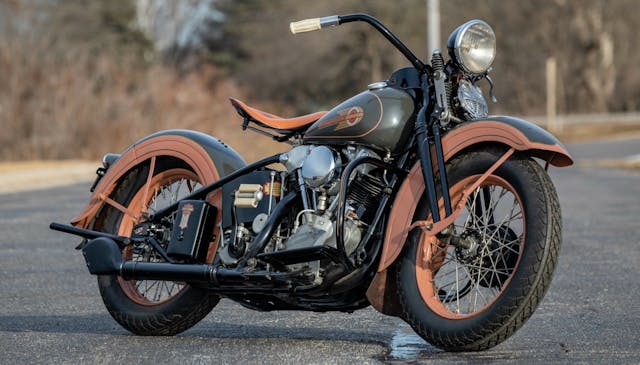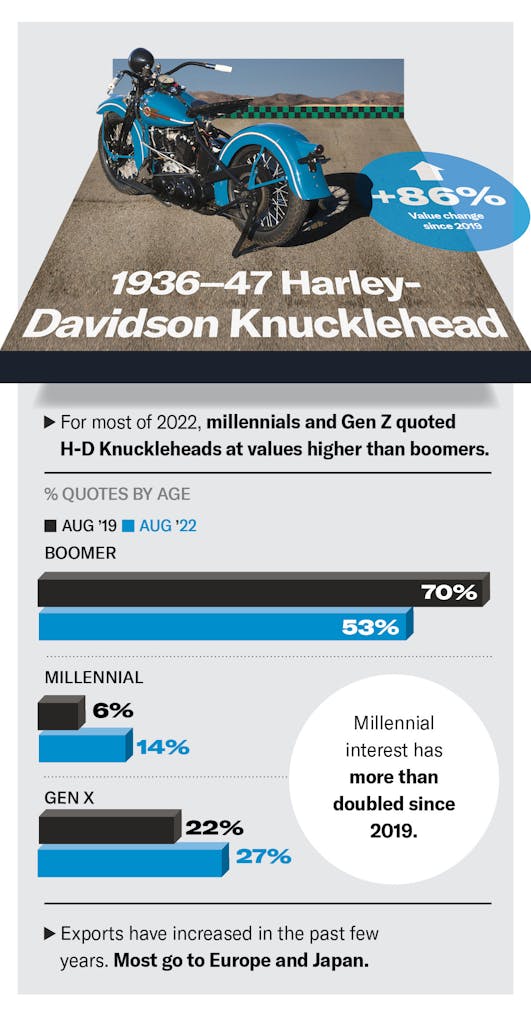Media | Articles
5 significant motorcycle sales from 2022
2022 was quite the year for collector motorcycles. We saw a 500cc two-stroke Grand Prix bike come up for sale twice on two sides of the world, a $60,000 BMW R90S smash records, and prewar motorcycles thrive. These are huge shakeups in the motorcycle world and significant moments in a market that operates far differently than the collector-car one, and at much lower values.
Motorcycle enthusiasts are a breed of their own, with an unparalleled passion for the hobby. These sales drove home the growth and vigor of the collector bike market. Let’s combine Hagerty’s number-crunching and my love of motorcycles to look into five of the most significant motorcycle sales of 2022.
Need to brush up on how we define each of our four vehicle conditions? All the details are here.
1936 Brough Superior 990cc SS100

Hagerty Price Guide #1 (Concours) condition value: $390,000
Marketplace
Buy and sell classics with confidence
The chart of record sales down the page shows just where this 1936 Brough Superior lies: smack in the middle of the decade that contains the majority of record motorcycle sales. Its sale price isn’t over the model’s #1 (or top) value. Nor even the #2 value. Yet this sale sheds light on the health of a market that some thought had stumbled.
The significance comes in three forms:
- Brough Superior motorcycles are blue-chip collectibles that benchmark the high-end collector market (think of the Mercedes-Benz 300SL and how we can use it to predict the car market’s future)
- British motorcycles have had many collectors watching for a drop as boomer interest for British motorcycles wanes and the Japanese market picks up steam with Gen-X and millennials.
- Anyone who idolized this bike when they were 20 years old is now 107. That person isn’t in the market for this bike today.
Brough Superior motorcycles are blue-chip collectibles that benchmark the high-end collector market (think the Mercedes-Benz 300SL and how we can use it to predict the car market’s future). This sale is emblematic of how top-flight prewar collector motorcycles transcend generations and have remained strong despite two key factors: age and increased competition.
Buyers are significantly younger than any of these prewar bikes, meaning they had no emotional tie to the bike when it emerged from the factory. Given that discrepancy, and the rise in popularity of Japanese collector motorcycles, many have sounded the death knell for British bikes. To each of those points, this Brough said, “not today.”
This motorcycle, like several Brough sales before it, commanded top dollar despite being in #4 (Fair) condition. It doesn’t run, was stored in a wet or flooded structure, and requires a full restoration. Demand clearly remains strong for these motorcycles regardless of condition. Their draw indicates an appreciation for the art and craftsmanship behind the creation of such a vehicle.
1996 Yamaha YZR500 OWJ1 Kenny Roberts Jr.

The motorcycle market massively values history, performance, and design. A 500cc two-stroke Grand Prix bike is about as iconic as racing motorcycles come for many enthusiasts today. The 500cc two-stroke era ignites every sensation: the smell of the fuel, the buzz and rattling from the engines, even the pain of seeing violent high-side crashes under sudden power.
This 1996 Yamaha YZR500, which hails from Kenny Robert’s final Yamaha Grand Prix team and was ridden by his son, Kenny Roberts Jr., represents the motorcycle equivalent of some of the most iconic and recognizable Ferrari F1 cars from the early 2000s. One such car, Michael Schumacher’s F2003 from the 2003 Formula 1 season just sold for $14.87M. Robert’s YZR500 just sold for a mere 46th of the price of the Schumacher F1 Ferrari, at $321,000. While less than its $400,000 asking price earlier last summer at RMD Motors, any price in that range represents some compelling market movement.
This is a massive outlay of cash for the motorcycle market, and those spending these amounts are doing in a calculated way, especially for more modern bikes. Motorcycles from the 1990s and onward may be on the rise, when sales like this one put one of their genre in the running for best-ever auction sales.
As evidenced in the chart below, the motorcycle record list is dominated by European and American motorcycles from the 1940s and earlier. Process this—the median year of the top 50 most expensive motorcycles at auction is 1938. For cars, it is 23 years newer: 1961.
The more money spent in a certain segment validates future spending at similar or higher prices, too. Top-tier modern Grand Prix and MotoGP motorcycles are leading the way as younger bikes gain a foothold at the top of the market.
1976 BMW R90S

HPG #1 condition value: $33,100
Let me be the bearer of bad news: Your R90S is not worth $63K because of this sale. This sale of an R90S, a bike that has commonly traded around $20K for a #1 (Concours) condition example, does not reset those #1 values to anywhere close to $60K. But that’s not why this sale matters.
Its significance rests on the vast value difference between a 100 percent, truly perfect and concours-ready bike compared to a 95 percet perfect bike. The above bike is that 100 percent perfect example, completed by one of the most respected R90S restorers with minute attention to detail. An example of investment-grade quality like this brought out the deepest of pockets in a growing and thriving market. It might be the first, and it might seem like a leap of faith for BMW R90S values, but as restorations become more expensive and parts harder to find, enthusiasts will likely ante up again.
Looking at other sales just shows how stratospheric this sale was, and how it has no relation to current mainstream R90S values. But the confidence of those who are putting the largest checks down on the table should make you feel good about the market’s trajectory.
1936 Harley-Davidson EL Knucklehead

Expensive does not mean significant, yet the two attributes are often linked. We use the top of the market to gauge trickle-down impacts to more affordably priced segments, to determine what is resonating with the big players in the collector world, and to see where investment money is landing, especially at a time when buyers are looking to assets to safeguard against inflation. This Knucklehead sold in August 2022 at a time of uncertainty: Interest rates had increased five-fold from only four months prior. That $182K sale price (right on its #1-condition value in our price guide) demonstrated market confidence in classic prewar American motorcycles (Knucklehead production did go slightly postwar, to 1947).
This is further supported by buying demand from younger generation. That may come as a shock to those who hear the drones of “Harleys are dying” and “young people don’t like motorcycles.” Ask a car enthusiast if the prewar American cars have a strong outlook and you likely won’t find much confidence, but it’s quite the opposite in the motorcycle market.
In fact, millennial interest in the 1936-1947 Harley-Davidson EL/FL Knucklehead more than doubled since 2019. The brand speaks to that younger audience in this segment, and a Knucklehead owner is twice as likely as an Indian Chief owner to be fewer than 40 years old. We took note of these significant data points and the strong sales, so much so we included the Knucklehead in our 2023 Hagerty Bull Market list.

1974 Maico GP250 Moto Cross

Despite not being street-legal and bucking the normal collector motorcycle trend of shunning plastic bits, dirt bikes have been an extremely hot segment over the last two years. Multiple sales of Maico models for up to $20,000—and even this 1980 model’s sale for $15,000—at Mecum’s 2022 Las Vegas motorcycle auction proves that it’s the segment, not just popular name brands, that have stood the test of time (Maico went bankrupt in 1983).
A large swath of buyers in the collector market are inspired by bikes of their youth regardless of how popular or known those bikes are today. When those cult followings coalesce around a segment, prices can skyrocket.
Other motorcycles that stand to benefit from this are the early big-bore two-strokes like Honda CR500s as well as the bikes that kickstarted the modern motocross era like the unobtanium Yamaha YZ250A. If this trend continues and dirt bikes find themselves further in the mainstream collector market, expect the poster bikes of Gen-X youth to win out. Sales like this little Maico’s give confidence to those watching.
Check out the Hagerty Media homepage so you don’t miss a single story, or better yet, bookmark it.







Kenney Roberts Bike
The ugliest thing on that Harley is the license plate!
Not sure about this but that black license from 1936 is a valuable collectible in its own right.
Why do we get duplicate articles?
I’ll repeat my answer. I’ll take the 1996 Yamaha YZR500 OWJ1.
I raced a Maico back in the day, I got rid of it after a year. It lived up to it’s nick name ( Maico – Breako ) Too many DNF’s. Maybe I should have kept it!